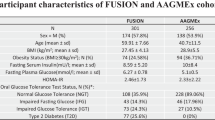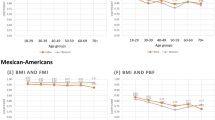Abstract
Aim:
SOCS3 gene plays an important role in the pathogenesis of obesity in animal models, but the data from human studies are relatively limited. To address this issue, a genetic association analysis on nationalities with different genetic background living in the similar environmental conditions was performed.
Methods:
Two thousand seven hundred eleven subjects were randomly recruited from the Kazakh, Uygur and Han nationalities in Xinjiang of China. SNP polymorphisms rs4969168 and rs9892622 within or near the SOCS3 gene were genotyped using TaqMan-MGB™ assay. Association study between the two polymorphisms and obesity-related traits (body mass index [BMI]; waist-to-hip ratio [WHR]; weight; height, waist, and hip measurements) was conducted.
Results:
Significant association was found between rs4969168 and the obesity-related traits, including BMI (25.32±3.49 kg/m2 for AA, 24.60±3.70 kg/m2 for AG, 24.39±3.42 kg/m2 for GG, P=0.042), weight (65.58±11.42 kg for AA, 63.50±11.30 kg for AG, 62.00±10.78 kg for GG, P=0.011) in the Han nationality, but not in the Kazakh or Uygur nationalities. Rs9892622 was significantly associated with BMI, WHR, and WAIST in the Uygur males. Rs9892622 was also associated with BMI in Kazakh males. Linear regression analysis verified the above findings. However, neither of the two polymorphisms was associated with obesity-related traits in the total population.
Conclusion:
The polymorphism rs4969168 within or near the SOCS3 gene has a significant effect in the Han nationality, while rs9892622 was associated with obesity in Uygur and Kazakh nationalities in Xinjiang of China.
Similar content being viewed by others
Log in or create a free account to read this content
Gain free access to this article, as well as selected content from this journal and more on nature.com
or
References
Marvelle AF, Lange LA, Qin L, Adair LS, Mohlke KL . Association of FTO with obesity-related traits in the Cebu Longitudinal Health and Nutrition Survey (CLHNS) Cohort. Diabetes 2008; 57: 1987–91.
Mori MA, Araújo RC, Reis FC, Sgai DG, Fonseca RG, Barros CC, et al. Kinin B1 receptor deficiency leads to leptin hypersensitivity and resistance to obesity. Diabetes 2008; 57: 1491–500.
Hill JO, Wyatt HR, Reed GW, Peters JC . Obesity and the environment: where do we go from here? Science 2003; 299: 853–5.
Coppari R, Ichinose M, Lee CE, Pullen AE, Kenny CD, McGovern RA, et al. The hypothalamic arcuate nucleus: a key site for mediating leptin's effects on glucose homeostasis and locomotor activity. Cell Metab 2005; 1: 63–72.
Howard JK, Flier JS . Attenuation of leptin and insulin signaling by SOCS proteins. Trends Endocrinol Metab 2006; 17: 365–71.
Lebrun P, Van Obberghen E . SOCS proteins causing trouble in insulin action. Acta Physiol (Oxf) 2008; 192: 29–36.
Münzberg H, Myers MG Jr . Molecular and anatomical determinants of central leptin resistance. Nat Neurosci 2005; 8: 566–70.
Talbert ME, Langefeld CD, Ziegler J, Mychaleckyj JC, Haffner SM, Norris JM, et al. Polymorphisms near SOCS3 are associated with obesity and glucose homeostasis traits in Hispanic Americans from the Insulin Resistance Atherosclerosis Family Study. Hum Genet 2009; 125: 153–62.
Jamshidi Y, Snieder H, Wang X, Spector TD, Carter ND, O'Dell SD . Common polymorphisms in SOCS3 are not associated with body weight, insulin sensitivity or lipid profile in normal female twins. Diabetologia 2006; 49: 306–10.
Hölter K, Wermter AK, Scherag A, Siegfried W, Goldschmidt H, Hebebrand J, et al. Analysis of sequence variations in the suppressor of cytokine signaling (SOCS)-3 gene in extremely obese children and adolescents. BMC Med Genet 2007; 8: 21.
Fischer-Rosinsky A, Fisher E, Kovacs P, Blüher M, Möhlig M, Pfeiffer AF, et al. Lack of association between the tagging SNP A+930-->G of SOCS3 and type 2 diabetes mellitus: meta-analysis of four independent study populations. PLoS One 2008; 3: e3852.
Gylvin T, Nolsøe R, Hansen T, Nielsen EM, Bergholdt R, Karlsen AE, et al. Mutation analysis of suppressor of cytokine signalling 3, a candidate gene in Type 1 diabetes and insulin sensitivity. Diabetologia 2004; 47: 1273–7.
Cecil JE, Tavendale R, Watt P, Hetherington MM, Palmer CN . An obesity-associated FTO gene variant and increased energy intake in children. N Engl J Med 2008; 359: 2558–66.
Emanuelli B, Peraldi P, Filloux C, Chavey C, Freidinger K, Hilton DJ, et al. SOCS-3 inhibits insulin signaling and is up-regulated in response to tumor necrosis factor-alpha in the adipose tissue of obese mice. J Biol Chem 2001; 276: 47944–9.
Acknowledgements
This study was supported by the Science and Technology Commission of the Shanghai Municipality (No 08DJ1400604 and 10ZR1439400).
Author information
Authors and Affiliations
Corresponding authors
Rights and permissions
About this article
Cite this article
Tang, W., Zou, Jj., Chen, Xf. et al. Association of two polymorphisms within and near SOCS3 gene with obesity in three nationalities in Xinjiang province of China. Acta Pharmacol Sin 32, 1381–1386 (2011). https://doi.org/10.1038/aps.2011.84
Received:
Accepted:
Published:
Issue date:
DOI: https://doi.org/10.1038/aps.2011.84
Keywords
This article is cited by
-
Obesity is associated with IL-6 gene polymorphisms rs1800795 and rs1800796 but not SOCS3 rs4969170
Molecular Biology Reports (2023)
-
Association analysis of SOCS3, JAK2 and STAT3 gene polymorphisms and genetic susceptibility to type 2 diabetes mellitus in Chinese population
Diabetology & Metabolic Syndrome (2022)
-
Fruit and vegetable intake modifies the associations between suppressor of cytokine signaling 3 genetic variants and type 2 diabetes
European Journal of Nutrition (2020)
-
Transcriptomics, metabolomics and histology indicate that high-carbohydrate diet negatively affects the liver health of blunt snout bream (Megalobrama amblycephala)
BMC Genomics (2017)
-
An epigenome-wide study of body mass index and DNA methylation in blood using participants from the Sister Study cohort
International Journal of Obesity (2017)



